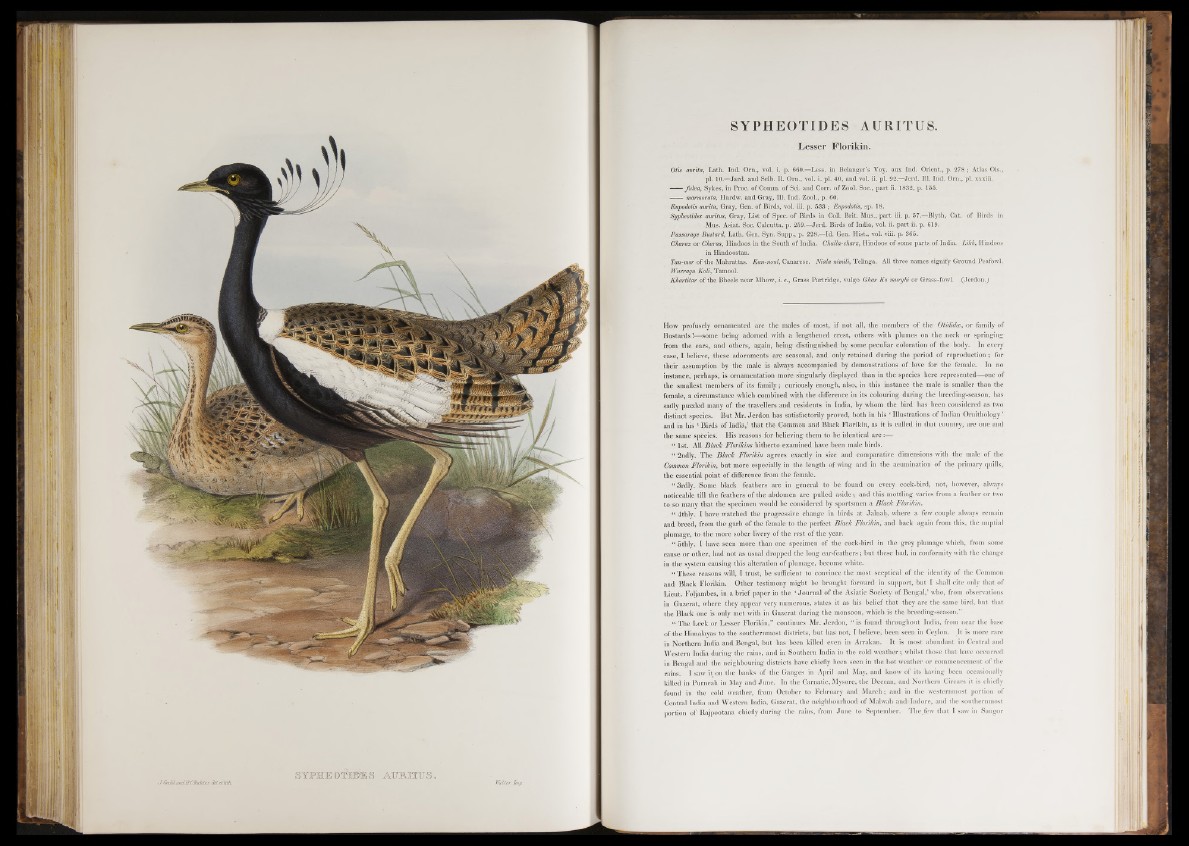
SYPHEOTIDES AURITUS.
Lesser Florikin.
Otis aurita, Lath. Ind. Ora., vol. i. p. 660.—Less, in Belanger’s Voy. aux Ind. Orient., p. 2 7 8 ; Atlas Ois.,
pi. 10.—Ja rd . and Selb. II. Ora., vol. i. pi. 40, and vol. ii. pi. 92.—Jerd. 111. Ind. Ora., pi. xxxiii.
fulva, Sykes, in Proc. o f Comm, of Sci. and Corr. o f Zool. Soc., p a r t ii. 1832, p. 155.
marmorata, Hardw. and Gray, 111. In d . Zool., p. 60.
Eupodotis aurita, Gray, Gen. o f B irds, vol. iii. p. 533 ; Eupodotis, sp. 18.
Sypheotides auritus, Gray, L ist o f Spec, o f Birds in Coll. Brit. Mus., p a r t iii. p. 57.—Blyth, Cat. o f Birds in
Mus. Asiat. Soc. Calcutta, p. 259.—-Jerd. Birds of India, vol. ii. p a r t ii. p. 619.
Passarage Bustard, Lath. Gen. Syn. Supp., p. 228.—Id. Gen. Hist., vol. viii. p. 365.
Charaz o r Charas, Hindoos in th e South of India. Ckulla-charz, Hindoos o f some p arts o f India. Lilch, Hindoos
in Hindoostan.
Tan-mor o f th e Mahrattas. Kan-noul, Canarese. Niala nimili, Telinga. All th ree names signify Ground Peafowl.
Wurragu Koli, Tamool.
Khartitar o f th e Bheels near Mhow, i. e., Grass Partridge, vulgo Ghas Ka murghi or Grass-fowl. (Jerdon.^
How profusely ornamented are the males of - most, if not all, the members o f the Otidides, or family of
Bustards!—f-some being adorned with a lengthened crest,, others with plumes on the .neck or springing
from the ears, and others, again, being distinguished by some peculiar coloration of the body. In every
case, I believe, these adornments are seasonal, and only retained during the period of reproduction; for
their assumption by the male is always accompanied by demonstrations of love for the female. In no
instance, perhaps, is ornamentation more singularly displayed than in the species here represented—one of
the smallest members of its family; curiously enough, also, in this instance the male is smaller than the
female, a circumstance which combined with the difference in its colouring during the breeding-season, has
sadly puzzled many of the.travellers and residents in India, by whom the bird has been considered as two
distinct species. But Mr. Jerdon has satisfactorily proved, both in his * Illustrations of Indian Ornithology ’
and in his ‘ Birds of India,’ that the Common and Black Florikin, as it is called in that country, are one and
the same species.' His reasons for believing them to be identical a r e :—
“ 1st. All Black Florikins hitherto examined have been male birds.
“ 2ndly. The Black Florikin agrees exactly in size and comparative dimensions with the male of the
Common Florikin, but more especially in the length of wing and in the acumination of the primary quills,
the essential point o f difference from the female.
“ 3rdly. Some black feathers are in general to be found on every cock-bird, not, however, always
noticeable till the feathers of the abdomen are pulled aside; and this mottling varies from a feather or two
to so many that the specimen would be considered by sportsmen a Black Florikin.
“ 4thly. I have watched the progressive change in birds at Jalnah, where a few couple always remain
and breed, from the garb of the female to the perfect Black Florikin, and back again from this, the nuptial
plumage, to the more sober livery of the rest of the year.
“ 5thly. I have seen more than one specimen of the cock-bird in the grey plumage which, from some
cause or other, had not as usual .dropped the long ear-feathers; but these had, in conformity with the change
in the system causing this alteration of plumage, become white.
“ These reasons will, I trust, be sufficient to convince the most sceptical of the identity o f the Common
and Black Florikin. Other testimony might be brought forward in support, but I shall cite only that of
Lieut. Foljambes, in a brief paper in the ‘ Journal of the Asiatic Society of Bengal,’ who, from observations
in Guzerat, where they appear very numerous, states it as his belief that they are the same bird, but that
the Black one is only met with in Guzerat during the monsoon, which is the breeding-season.”
“ The Leek or Lesser Florikin,” continues Mr. Jerdon, “ is found throughout India, from near the base
of the Himalayas to the southernmost districts, but has not, I believe, been seen in Ceylon. It is more rare
in Northern India and Bengal, but has been killed even in Arrakan. It is most abundant in Central and
Western India during the rains, and in Southern India in the cold weather; whilst those that have occurred
in Bengal and the neighbouring districts have chiefly been seen in the hot weather or commencement of the
rains. I saw it on the banks of the Ganges in April and May, and know o f its having been occasionally
killed in Purneah in May and June. In the Carnatic, Mysore, the Deccan, and Northern Circars it is chiefly
found in the cold weather, from October to February and March; and in the westernmost portion of
Central India and Western India, Guzerat, the neighbourhood of Malwah and-Indore, and the southernmost
portion of Rajpootana chiefly during the rains, from June to September. The few that I saw in Saugor